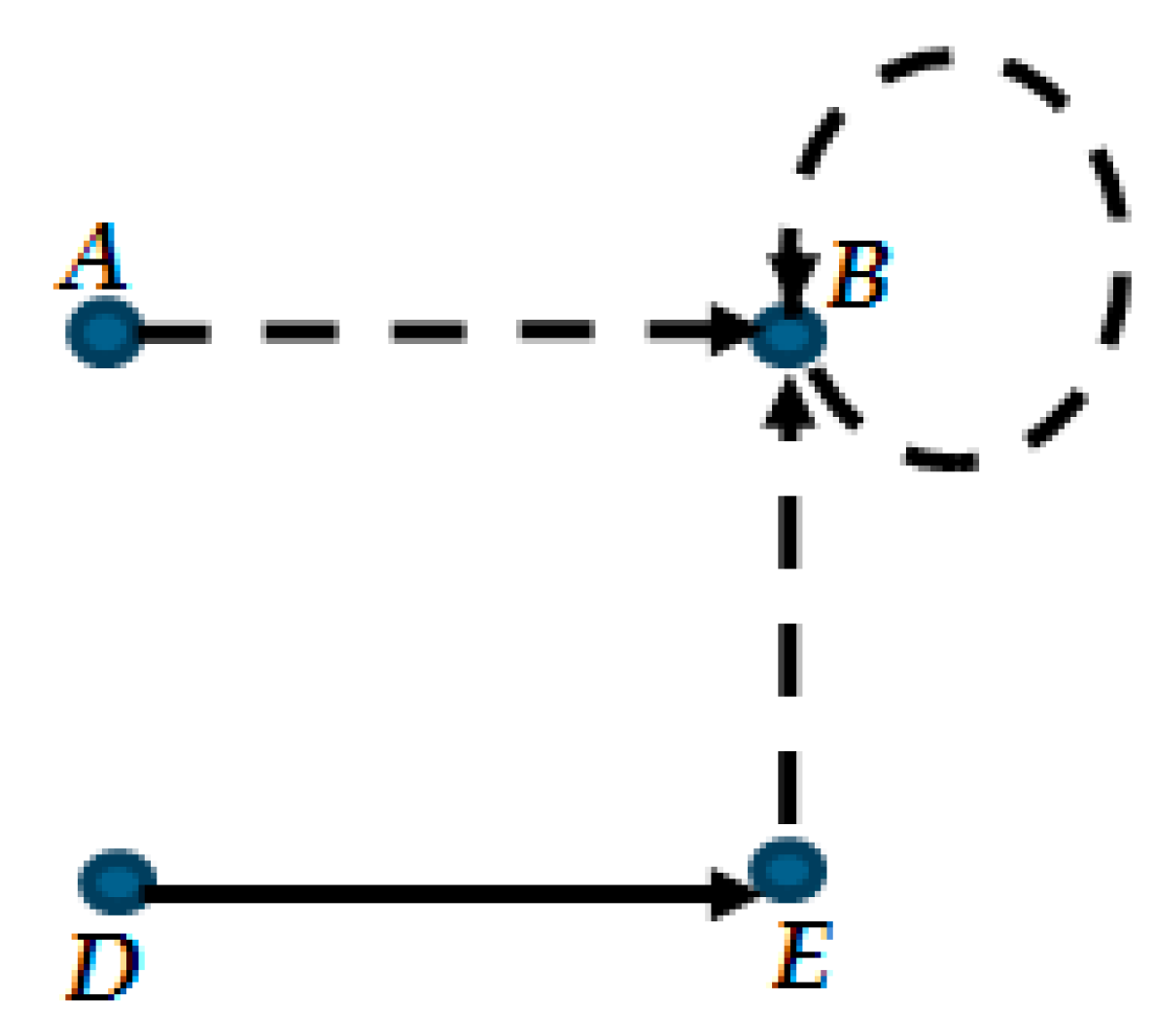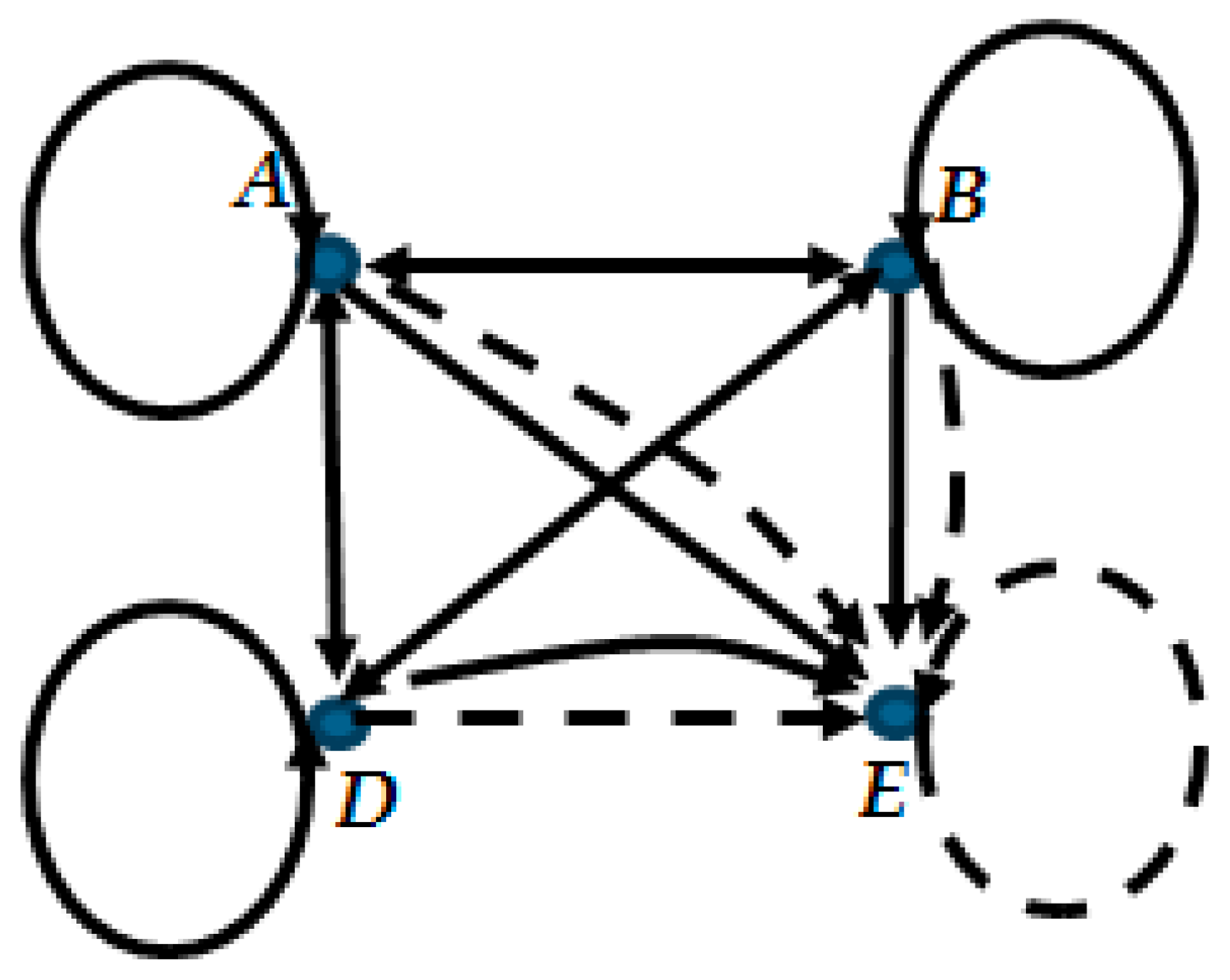Truth-Teller–Liar Puzzles with Self-Reference
Abstract
1. Introduction
2. Strong Truth-Teller and Strong Liar Puzzles (SS-Puzzles)
- Person is Truth-Teller if the following condition satisfies for every :if said atomic statement about , and this atomic statement is in the form:
- ➢
- “ is a Liar”, then is a Liar (the atomic statement is true).
- ➢
- “ is a Truth-Teller”, then is a Truth-Teller (the atomic statement is true).
- Person is Liar if the following condition satisfies for every :if said atomic statement about , and this atomic statement is in the form:
- ➢
- “ is a Liar”, then is a Truth-Teller (the atomic statement is false).
- ➢
- “ is a Truth-Teller," then is a Liar (the atomic statement is false).
- If personis Truth-Teller, then for allwho said atomic statement about, the atomic statement is in the form:
- ➢
- “is a Liar”, thenis a Liar.
- ➢
- “is a Truth-Teller”, thenis a Truth-Teller.
- If personis Liar, then for allwho said atomic statement about, the atomic statement is in the form:
- ➢
- “is a Liar”, thenis a Truth-Teller.
- ➢
- “is a Truth-Teller”, thenis a Liar.
3. Strong Truth-Teller, Strong Liar and Strong Crazy Puzzles (SSS-Puzzles)
- Strong Truth-Teller (T) and Strong Liar (L) previously have been defined (see Definition 3).
- A person is a Strong Crazy person (C) if all of his/her statements are self-contradictory statements (if he/she says any statement).
- is Truth-Teller exactly as in Definition 5.
- Personis Liar if the following holds for every:ifsaid atomic statement about, then this atomic statement is in the form:
- ➢
- “is a Liar”, thenis a Truth-Teller or a Crazy (not a Liar).
- ➢
- “is a Truth-Teller”, thenis a Liar or a Crazy (not a Truth-Teller).
- Personis a Crazy person ifsaid only self-contradictory statements.
3.1. Graph Representation of the Puzzle
- Nodes represent the persons.
- Directed edges represent the atomic statements:
- ■
- Solid edge from A to B: A said that B is a Truth-Teller ().
- ■
- Broken edge from A to B: A said that B is a Liar ().
- In graph G, if two persons say the same type of statements about each other, then the representation of these statements, the two edges pointing in opposite directions, can be substituted by a bidirectional same type (i.e., broken or solid) edge between the two nodes.
3.2. Notations and Definitions
- N: The set of all people in the puzzle.
- G is the graph representation of the puzzle.
- T is the set of Strong Truth-Tellers, L is the set of Strong Liars, and C is the set of Strong Crazy people in the puzzle. T, L and C are disjoint sets; moreover, N = T L C.
- True atomic statements : The set of all statements that are logically true.
- False atomic statements (): The set of all statements that are logically false.
- Paradoxical statements (): The set of all self-contradictory statements in the puzzle.
3.3. Preliminary Results
3.4. Analyzing SSS-Puzzles
- and
- /such that the type ofis the same as the type of, and(or),thenand.
4. Comparing SS-Puzzles and SSS-Puzzles
5. Conclusions
Author Contributions
Funding
Acknowledgments
Conflicts of Interest
References
- Chesani, F.; Mello, P.; Milano, M. Solving Mathematical Puzzles: A Challenging Competition for AI. AI Mag. 2017, 38, 83. [Google Scholar] [CrossRef]
- Smullyan, R. Forever Undecided (A Puzzle Guide to Gödel); Alfred A. Knopf: New York, NY, USA, 1987. [Google Scholar]
- Kolany, A. A general method of solving Smullyan’s puzzles. Log. Log. Philos. 1996, 4, 97–103. [Google Scholar] [CrossRef]
- Lusk, E.; Wos, L.; Overbeek, R.; Boyle, J. Automated Reasoning: Introduction and Applications; McGraw-Hill: New York, NY, USA, 1992. [Google Scholar]
- Nagy, B.; Kósa, M. Logical puzzles (Truth-tellers and liars). In Proceedings of the 5th International Conference on Applied Informatics, Eger, Hungary, 28 January–3 February 2001; pp. 105–112. [Google Scholar]
- Nagy, B.; Allwein, G. Diagrams and Non-monotonicity in Puzzles. In Proceedings of the International Conference on Theory and Application of Diagram, Cambridge, UK, 22–24 March 2004; Springer: Berlin/Heidelberg, Germeny, 2004; pp. 82–96. [Google Scholar]
- Holliday, R.L. Liars and Truthtellers: Learning Logic from Raymond Smullyan. Math Horiz. 2005, 13, 5–29. [Google Scholar] [CrossRef]
- Cook, R.T. Knights, knaves and unknowable truths. Analysis 2006, 66, 10–16. [Google Scholar] [CrossRef]
- Rosenhouse, J. Knights, knaves, normals, and neutrals. Coll. Math. J. 2014, 45, 297–306. [Google Scholar] [CrossRef]
- Shasha, D.E. The Puzzling Adventures of Dr. Ecco; W.H. Freeman: New York, NY, USA, 1998. [Google Scholar]
- Nagy, B. Truth-teller, Liar puzzles and their graphs. Cent. Eur. J. Oper. Res. 2003, 11, 57–72. [Google Scholar]
- Nagy, B. SW puzzles and their graphs. Acta Cybernet. 2003, 16, 67–82. [Google Scholar]
- Nagy, B. SS-típusú igazmondó-hazug fejtörők gráfelméleti megközelítésben (SS-type truthteller-liar puzzles and their graphs, in Hungarian with English summary). Alkalmazott Matematikai Lapok 2006, 23, 59–72. [Google Scholar]
- Aszalós, L. The Logic of Knights, Knaves, Normals and Mutes. Acta Cybernet. 2000, 14, 533–540. [Google Scholar]
- Nagy, B. Boolean programming, truth-teller-liar puzzles and related graphs. In Proceedings of the 25th IEEE International Conference on Information Technology Interfaces, Cavtat, Croatia, 16–19 June 2003; pp. 663–668. [Google Scholar]
- Howse, J.; Stapleton, G.; Burton, J.; Blake, A. Picturing Problems: Solving Logic Puzzles Diagrammatically. In Proceedings of the International Workshop on Set Visualization and Reasoning (SetVR 2018), Edinburgh, UK, 18 June 2018; pp. 12–27. [Google Scholar]
- Yablo, S. Knights, Knaves, Truth, Truthfulness, Grounding, Tethering, Aboutness, and Paradox. In Raymond Smullyan on Self Reference; Springer: Cham, Switzerland, 2017; pp. 123–139. [Google Scholar]




| Can Say False Statements | Cannot Say False Statements | |
|---|---|---|
| Can say true statements | Normal | Knight/Truth-Teller |
| Cannot say true statements | Knave/Liar | Mute |
| Can Say False Statements | Cannot Say False Statements | |
|---|---|---|
| Can say true statements | Normal | Truth-Teller |
| Cannot say true statements | Liar | Crazy |
| Puzzle Type | Two-Person Puzzle | Three-Person Puzzle | Four-Person Puzzle | |||
|---|---|---|---|---|---|---|
| SSS-Puzzle | SS-Puzzle | SSS-Puzzle | SS-Puzzle | SSS-Puzzle | SS-Puzzle | |
| Good puzzles | 9 | 0 | 553 | 0 | 136,017 | 0 |
| Solvable puzzles | 41 | 28 | 2619 | 1880 | 668,849 | 506,896 |
| Unsolvable puzzles | 40 | 53 | 17,064 | 17,803 | 42,377,872 | 42,539,825 |
| Total | 81 | 81 | 19,683 | 19,683 | 43,046,721 | 43,046,721 |
| Puzzle Type | Two-Person Puzzle | Three-Person Puzzle | Four-Person Puzzle | |||
|---|---|---|---|---|---|---|
| SSS-Puzzle | SS-Puzzle | SSS-Puzzle | SS-Puzzle | SSS-Puzzle | SS-Puzzle | |
| Good puzzles | 9 | 0 | 553 | 0 | 136017 | 0 |
| Two-solution puzzles | 18 | 24 | 1467 | 1728 | 443876 | 490752 |
| Three-solution puzzles | 10 | 0 | 411 | 0 | 66836 | 0 |
| Four-solution puzzles | 1 | 4 | 51 | 144 | 7350 | 15552 |
| Five-solution puzzles | 0 | 0 | 24 | 0 | 3963 | 0 |
| Puzzles with more than five solutions | 3 | 0 | 113 | 8 | 10807 | 592 |
| Number of Crazy Persons in the Solution | Two-Person Puzzle | Three-Person Puzzle | Four-Person Puzzle |
|---|---|---|---|
| One | 8 | 504 | 124480 |
| Two | 1 | 48 | 11328 |
| Three | - | 1 | 208 |
| Four | - | - | 1 |
© 2020 by the authors. Licensee MDPI, Basel, Switzerland. This article is an open access article distributed under the terms and conditions of the Creative Commons Attribution (CC BY) license (http://creativecommons.org/licenses/by/4.0/).
Share and Cite
Alzboon, L.; Nagy, B. Truth-Teller–Liar Puzzles with Self-Reference. Mathematics 2020, 8, 190. https://doi.org/10.3390/math8020190
Alzboon L, Nagy B. Truth-Teller–Liar Puzzles with Self-Reference. Mathematics. 2020; 8(2):190. https://doi.org/10.3390/math8020190
Chicago/Turabian StyleAlzboon, Laith, and Benedek Nagy. 2020. "Truth-Teller–Liar Puzzles with Self-Reference" Mathematics 8, no. 2: 190. https://doi.org/10.3390/math8020190
APA StyleAlzboon, L., & Nagy, B. (2020). Truth-Teller–Liar Puzzles with Self-Reference. Mathematics, 8(2), 190. https://doi.org/10.3390/math8020190





